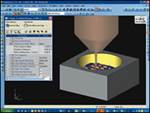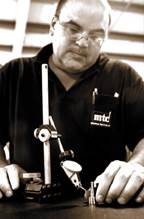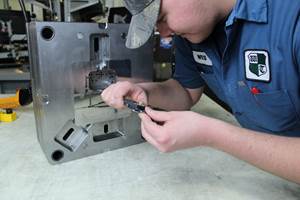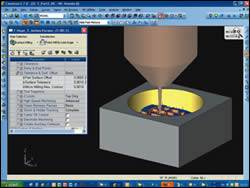Harnessing EDM Technology for Micromoldmaking
For moldmakers considering making their foray into micromoldmaking, a solid understanding of the benefits of new EDM technologies is necessary to make the transition as smooth as possible.
To maintain a competitive advantage in the global marketplace, many of today’s American mold-makers are differentiating their EDM capabilities by embracing micromoldmaking. Because of the complex, precise nature of the parts produced, those willing to adopt the technologies necessary to reliably produce micromolds open the doors to serve a growing segment of the market.
Many think of micromoldmaking simply as using a very small electrode to produce components. In reality, a more precise definition is the use of an electrode smaller than 0.1" x 0.1" that contains some fine details, such as lettering or very fine ribs. Some common uses for micromolds include dental braces, medical components used in small arterial surgeries and microchips. Additionally, increased investment in nanotechnology is driving the development of micromolds to produce components complementary to that sector and many others.
For moldmakers considering making their foray into micromoldmaking, there are several important points to consider. A solid understanding of the benefits of new EDM technologies is necessary to make the transition as smooth as possible.
The Challenge of Measuring Parts
When dealing with such small parts, a shop producing micromolds must be able to accurately measure components to guarantee that cavities are created correctly. At first, it would seem obvious that the part could be removed from the machine and taken to a CMM for measurement. Unfortunately, if a micromold is not burned to the correct depth, it is extremely difficult, if not impossible, to replace it accurately enough to resume the cutting process. Being off by even 0.0001" can cause vital features of a micromold to be destroyed, resulting in the component being scrapped.
A more reliable method would be to use chucks. If a part is mounted on a pallet and then placed on a chuck inside of a machine, it can be removed to be measured and then placed back into the machine in the exact same position for reburning. While the high accuracy of today’s chucks allows this system to work very well, it also is an expensive option.
To accurately and reliably measure parts without investing in a chuck system, one can select a diesinking EDM that contains a built-in probe. The use of this type of probe allows the size and depth-of-cut to be measured to 0.000001" without removing the part from the machine.
Keeping Things Cool
The extremely high accuracy and precision requirements of micromolding make some factors much more important than they would be in normal EDM environments. In particular, temperature plays a very large role in the ability to reliably manufacture parts. Even small variations in the temperature of the machine or production environment are enough to affect a machine with a cast iron base, causing inaccuracy and ruining parts.
Many micromoldmakers address the issue of temperature by designing and constructing state-of-the-art, climate-controlled work areas. This is an ideal solution, as a climate-controlled room with no exposure to outside sunlight can reliably hold temperatures to ±1° Fahrenheit. For those without the resources or space to install such a work area, production may be limited to times of the day when the outside temperature tends not to fluctuate, such as early morning before the sun rises or late in the afternoon when it begins to recede.
Advances in machine design also allow shops to achieve higher levels of thermostability. A double thermostabilization system for machines used in micromoldmaking has been developed.1 The system monitors the temperature of the dielectric and then pulses air cooled by the dielectric through the machine to maintain a consistent temperature. Dielectric also is circulated through the worktable to prevent thermal shocks that can occur when filling the tank. Systems such as this aid micromoldmakers in achieving more reliable production.
Electrode Considerations
In addition to the effects of temperature on the machine and external environment, micromoldmakers must consider how heat will affect electrode performance. Traditionally, graphite electrodes are used with EDMs in the U.S. These prove unsuitable for micromoldmaking, as the machining process wears out intricate details too quickly. Because of this, copper electrodes must be used, creating another challenge to be overcome.
While graphite does not expand due to heat, copper does. To counter this issue, multiple electrodes should be used. By using separate electrodes for roughing, finishing and fine finishing, micromoldmakers can avoid having heat build up to the point of causing an electrode to machine a part out of tolerance.
Thermal properties of materials are not the only aspect of electrodes to be accounted for when producing micromolds. The cost of producing electrodes for micromoldmaking is significantly higher than that of producing electrodes for standard EDM’ing. Their production requires machines with higher spindle speeds, accuracy and reliability than what are found in traditional milling machines. Unless the production of electrodes is to be outsourced, this is an important consideration for shops considering making the move to micromoldmaking.
Avoid Investing in the Wrong Technology
When considering the production of micromolds, many manufacturers may initially consider purchasing a diesinking EDM with additive. On its surface, this looks like a wise choice, as this new technology reduces electrode wear, while increasing the speed of cut and surface finish quality. Unfortunately, the undersize details of micromolds are typically smaller than the particle size in an additive mix. This means that it is impossible to produce the tighter corners or radii necessary for the components. While this technology can provide significant benefits in some areas of moldmaking, it is typically the wrong choice for micromoldmaking.
1 GF AgieCharmilles developed the double thermostabilization system.
Related Content
Five-Axis Graphite Mill With Automation Debottlenecks Electrode Machining
Five-axis electrode cutting enabled Preferred Tool to EDM complex internal screw geometry on an insert that otherwise would have had to be outsourced.
Read MorePredictive Manufacturing Moves Mold Builder into Advanced Medical Component Manufacturing
From a hot rod hobby, medical molds and shop performance to technology extremes, key relationships and a growth strategy, it’s obvious details matter at Eden Tool.
Read MoreMachine Monitoring Platform Improves Machine Utilization, On-Time Delivery
Using data from a machine monitoring platform, Westminster Tool added almost 75 hours of capacity per week by shortening warmups and starting CNC and EDM machines sooner.
Read MoreMMT Chats: 4 Keys to a Successful Mold-Building Operation: Innovation, Transparency, Accessibility and Relationship
MoldMaking Technology Editorial Director Christina Fuges chats with Steve Michon, co-owner of Zero Tolerance in Clinton Township, Michigan, about the excitement of solving problems, the benefits of showing gratitude, the real struggle with delegation and the importance of staying on top of technology. This episode is brought to you by ISCAR with New Ideas for Machining Intelligently.
Read MoreRead Next
Micromoldmaking: It’s a Small World After All
A great deal of attention needs to be paid to the design and build process—as well as post-moldmaking processes—when making molds for tiny parts.
Read MoreOpportunities for Mold Shops with Micro Molds and Micro Milling
Learning about the trends and challenges with micro molds and micro milling will help shops maintain their competitive edge.
Read MoreMiniature Tool & Die: Good Things Come in Small Packages
Micro molding and micro EDM'ing help a moldmaker fine-tune its niche and double sales in a year's time.
Read More.jpg;maxWidth=970;quality=90)














.jpg;maxWidth=300;quality=90)

_300x250 4.png;maxWidth=300;quality=90)










